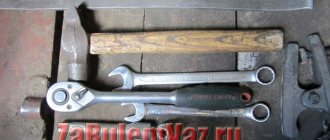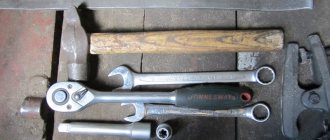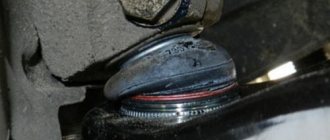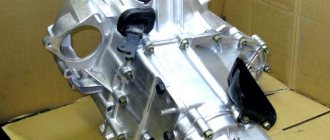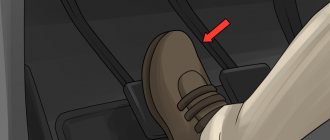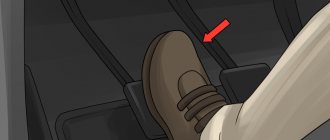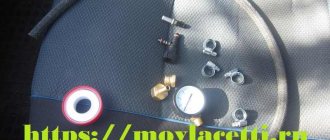Purpose of ball joints VAZ 2107
A ball joint (BJ) is an ordinary hinge built into the VAZ 2107 suspension and allows the wheel to move only in a horizontal plane. At the same time, it limits the possibility of wheel movement in the vertical direction.
Ball joints on the latest versions of the VAZ 2107 have become more compact
Ball joints of the VAZ 2107 are very short-lived, so they have to be changed often.
Design of ball joints VAZ 2107
Previously, passenger cars did not have ball joints. They were replaced by bulky king pins that had to be lubricated frequently. The mobility of such compounds left much to be desired. This, in turn, negatively affected the car's handling. The designers of the VAZ 2107 abandoned the kingpins and installed ball joints. The first SHO consisted of:
- housings;
- ball pin;
- springs;
- anther
The finger was pressed into a fixed eye, fixed with a powerful spring and covered with a boot. This structure also needed to be lubricated periodically, but quite rarely (about twice a year). The lubricant on the pins had to be changed every week.
Modern ball joints do not use springs
Subsequently, the VAZ 2107 SHO was constantly improved:
- the spring disappeared from the structure;
- the steel boot was replaced with a plastic one;
- the fixed eyelet in which the finger was fixed became more compact and received a plastic external finish;
- SHOs have become non-separable, that is, practically disposable.
One driver I know assured me that he had found a great way to extend the life of plastic boots. Before installing new ball joints, he always applied a thick layer of silicone ointment to the boots, which car owners use to prevent the rubber bands on car doors from freezing in winter. From his words, it turned out that the anthers after such a procedure become practically “indestructible.” When I asked how an ointment intended for rubber could improve the quality of plastic, I was recommended to just try it and see for myself. Unfortunately, we never got around to it. So I leave it to the reader to check this driver’s find.
Reasons for failure of VAZ 2107 ball joints
The main reasons for SHO failure are as follows:
- Alternating shock load. As a result, the ball pin pressed into the suspension eye is destroyed. The support is designed in such a way that the shock loads on the pin ball are very high. When the quality of roads is poor, these loads increase manifold. In such conditions, even a high-quality SHO will not be able to fully exhaust its resource.
- Lack of lubrication. Under the influence of shock loads, the lubricant is gradually squeezed out of the SHO. In addition, over time, the lubricant loses its original properties.
- Anther destruction. The boot protects the hinge joint from dirt. If a crack appears in it, the dirt that gets into the joint turns into an abrasive material and grinds down the surface of the ball pin.
Dirt gets into the joint through a crack in the boot and wears down the surface of the ball pin.
Signs of malfunction of VAZ 2107 ball joints
The main symptoms of a VAZ 2107 SHO malfunction include:
- Extraneous sounds. While driving, a knocking or grinding noise begins to be heard from the wheel. This is especially pronounced on uneven roads at a speed of about 30 km/h and is usually a consequence of partial destruction of the ball on the support pin.
- Wheel rocking. When accelerating, the wheel begins to sway slightly in different directions. This happens due to the backlash that occurs in the SHO due to its wear. The situation is quite dangerous, and the backlash must be eliminated quickly. Otherwise, the wheel may turn at a right angle to the body at speed.
Play in the ball joint causes the front wheel to sway, which can spin out at speed.
- Grinding and squeaking noise when turning the steering wheel left or right. The reason is the lack of lubrication in one of the SHOs (usually only one of the supports fails).
- Uneven wear on front and rear tires. This can happen not only due to faulty SHOs. The cause of uneven wear may be incorrectly adjusted camber and toe-in, insufficient or excessive air pressure in individual wheels, etc.
This is interesting: Where is the engine number of the VAZ Priora
How to check steering rods, rod ends and ball joints on a VAZ 2101-VAZ 2107?
Note! It will be most convenient to carry out the check in the so-called ditch, because all the elements of the chassis are located only at the bottom of the car, so you will have to crawl under it!
And also keep in mind one important thing: you need to check the condition of all parts only in such a way that both front wheels of the car are loaded with the entire weight of the car, so if you decide to check the condition of the parts on a lift, take this detail into account and, if possible, place stops under the front wheels, and then lower the car slightly so that the front part is completely loaded!
1) To do this, first, using a metal brush, clean all the hinges from adhering dirt, for more convenient and precise work.
Note! Clean the hinges carefully, because they are equipped with boots that can be damaged very easily! (For example, the boot is indicated by an arrow in the photo)
2) Next, inspect the condition of these same anthers; cracks, as well as peeling from the edging or tears of the rubber itself are not allowed.
3) After this, take the boot with your hand and squeeze it; grease coming out from under the boot is also not allowed.
Note! Do the same job of checking the boot with the remaining hinges; if you find any defects on the boot, replace it! (You can change the anthers using the example of that article entitled: “Replacing steering rods”, a link was given to it a little higher)
4) Now, to check the ball joints for serviceability, take a marker in your hands and use it to mark all the plugs of each joint for a more accurate replacement.
5) After making the mark, take a caliper and use it to check the full height of the hinge tip, and after checking, remember the resulting value.
6) Then use a mounting shovel to support the rod end upwards as far as possible. After this, use a caliper to measure the height of the hinge again, while holding the tip with a mounting shovel, and after measuring, remember the resulting value or write it down.
Note! When both values are obtained, compare them, the average value that you should fluctuate between the first measurement and the second should be “1-1.5 mm”, but no more. If the value is too large or too small, replace the hinges with new ones!
7) Next, check the remaining hinges for serviceability, first measuring their height in a quiet state, and then supporting them for this with the same mounting shovel, and then re-measuring the height and comparing both values.
 Next, if you want to understand whether there is play in the joint, then to do this, ask an assistant to sit in your car and gently rock the steering wheel in both directions.
Next, if you want to understand whether there is play in the joint, then to do this, ask an assistant to sit in your car and gently rock the steering wheel in both directions.
Note! And at this time you will have to grab the hinge body with your hand, but pay attention to the photo, your thumb must be on the bipod. After you grab your hand, ask your assistant to shake the steering wheel and as a result you will feel play if there is any in the system!
9) After the operation, check the remaining hinges for play, and replace those hinges that have play.
Note! If you replace the hinges, then after replacing them, be sure to adjust the toe-in of the wheels, using the article entitled: “Adjusting the toe-in and camber of the wheels of a car”!
Addition: In addition, we recommend that you also check the play of the pendulum arm, for this:
1) First, grab the pendulum lever itself with your hand and then swing it up and down with decent force, thereby determining whether there is play in the lever or not.
https://youtu.be/https://youtu.be/Aw1H8p2Kc1E
_
Parts selection
The main enemies of the upper and lower ball joints are not only water or dirt, but also low-quality materials. It is best to purchase spare parts made of steel, as they are the most durable and wear-resistant. Any auto store will tell you which companies produce such parts. Also, reviews of other VAZ 2107 car owners can help you in your choice. Most of them recommend paying attention to domestic manufacturers, since cheap Chinese analogues can fail at any time.
- pressure plate;
- ball pin cover;
- upper ball pin.
Also check out
- To avoid turning your finger, you need to clamp the lever with a mounting tool.
- Remove the ball joint fasteners to the upper arm.
- Remove the ball.
- Clean the place where the ball joint sits on the lever (there should be no damage or cracks on it).
- Remove the sealing washer from the old ball joint and install it on the new one.
- Before installing the ball joint, you need to lubricate it with ShRB-4 or Litol-24.
- Install the boot and washer.
- Screw the ball onto the lever. Place it in your fist and tighten the nut.
- Unscrew the nut from the lower ball joint. Usually this causes the finger to start scrolling. To avoid this, it is necessary to create a lateral tension at the connection between the fist and the finger, for which a mounting is inserted in the gap between the brake shield and the fist. If there is no result in the gap between the fist and the lower arm, you should install an adjustable pin, and then use it to fix the pin.
- After the nut is unscrewed, you can raise your fist up. Place the key at “22” between the upper cavity of the fist and the lower lever.
- Remove the VAZ 2107 ball joint .
- Remove rust and dirt from the seat.
- Check the presence of lubricant in the lower part of the ball joint by unscrewing the plug with a “7” key. If there is no grease there, fill the ball with grease using a medical syringe without a needle.
- It will be interesting: Instructions for replacing the CV joint on a VAZ 2110 with your own hands
- Place the ball joint in place at the bottom of the lever and screw it to the knuckle.
- After this, we can say that replacing the ball joints with your own hands has been successfully completed.
About choosing ball joints
As mentioned above, the most important part of the support is the ball pin. The reliability of the suspension as a whole depends on its durability. Therefore, the requirements for high-quality fingers are very serious:
- a good ball pin should be made of high alloy steel;
- the surface of the finger (but not the ball) must be hardened;
- the pin and other parts of the support must be made using the cold heading method and only after that subjected to heat treatment.
The nuances of the technological process listed above are very expensive, so they are used only by large manufacturers of ball joints, of which there are not many on the domestic market. Let's list them:
The products of these four companies are in constant high demand among VAZ 2106 owners. It should be noted here that currently the market is literally flooded with fake ball joints for VAZ classics. Fortunately, it’s quite easy to recognize a fake: it costs half as much as the same “Trek” or “Kedar”. But saving on such an important detail is categorically not recommended.
